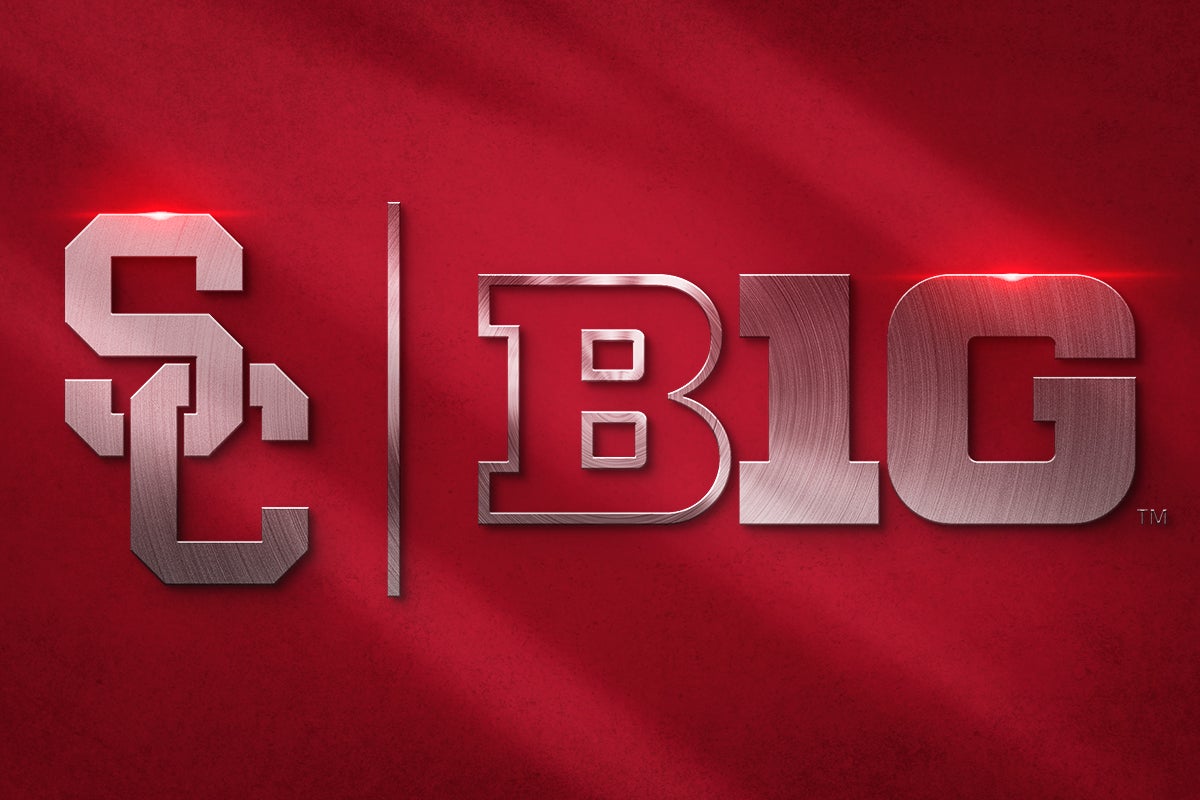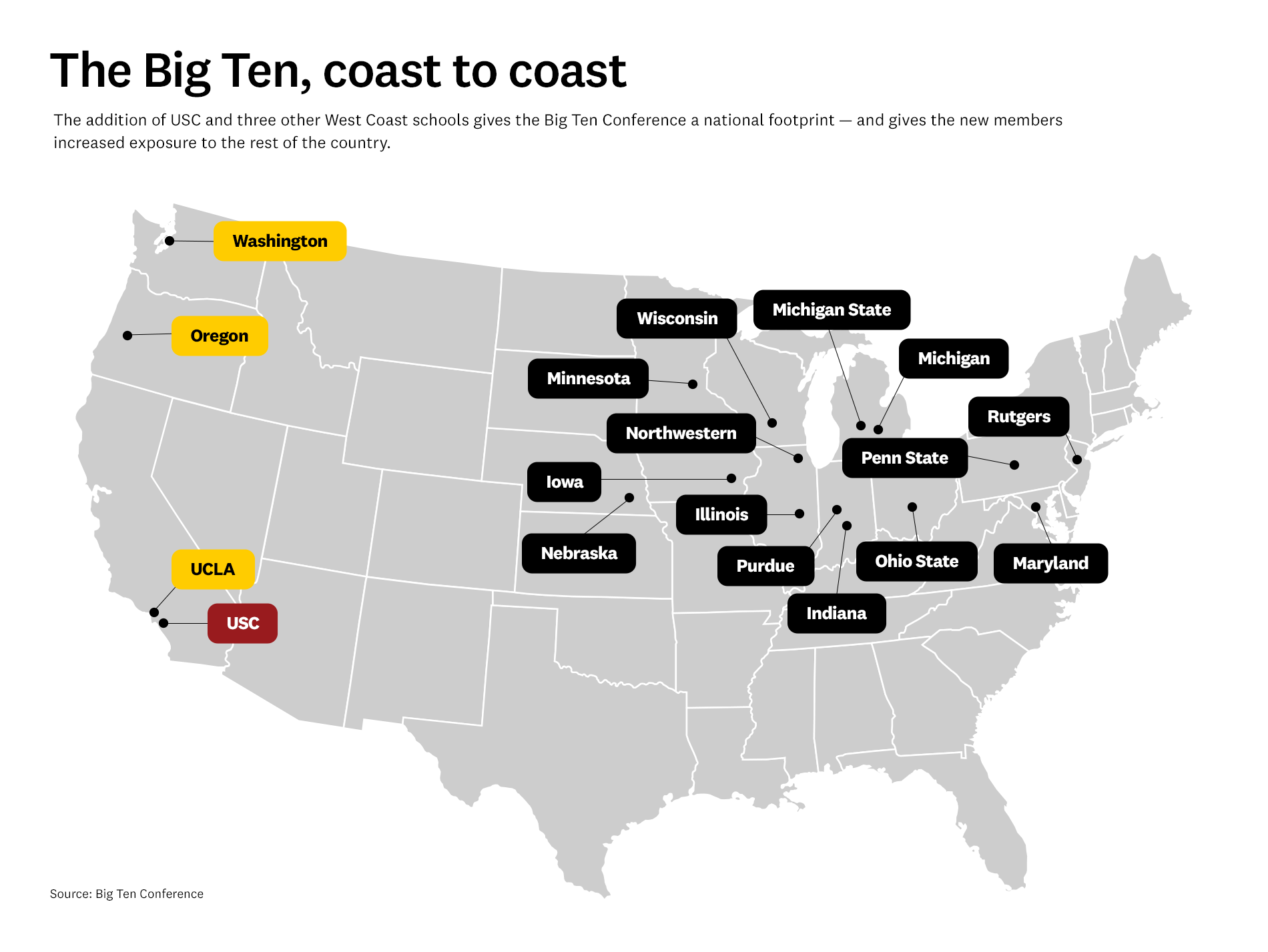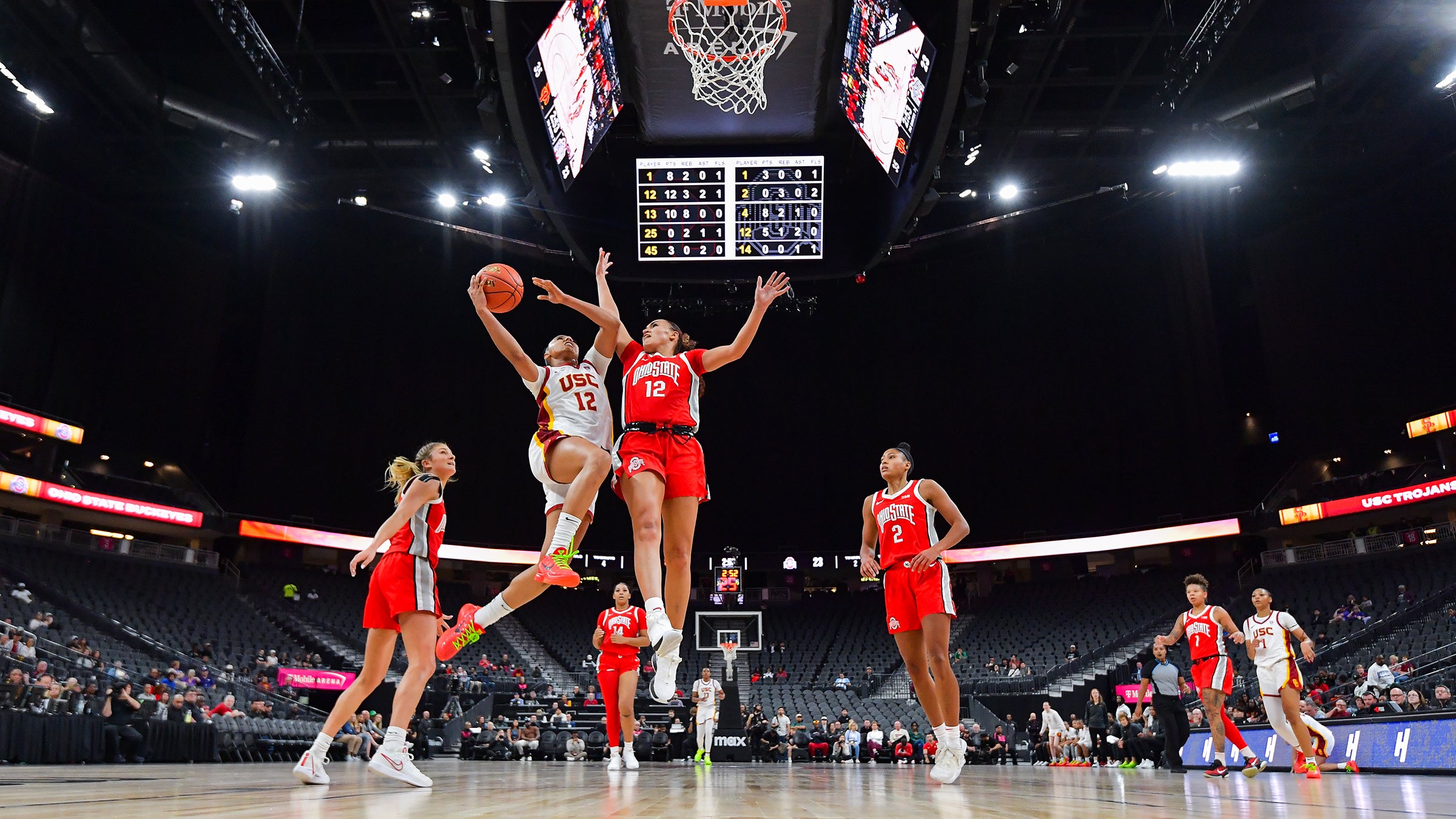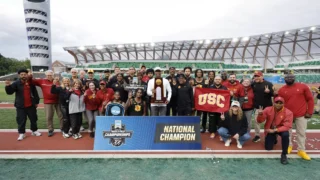The 2017 Rose Bowl was a classic Pac-12/Big Ten face-off. USC pulled out a win 52-49 over Penn State as time ran out. (USC Photo/John McGillen)
Athletics
USC takes its place in the Big Ten, a move years in the making
The university joins the oldest and one of the most successful conferences, bringing big benefits on and off the playing field.
Two years after USC stunned the collegiate athletics world by announcing it would join the Big Ten Conference, the university on Friday formally became part of that venerable sports league. The new-look Big Ten has been more than 100 years in the making, with a reach that now extends from coast-to-coast and into much more than just athletics, including academics, research and more.

“This is the dawn of a new era for USC Athletics,” USC President Carol Folt said. “At this critical moment when there are seismic changes coming across the athletics landscape, it was fortuitous that we made this commitment two years ago. We are prepared and we are ready. We are well positioned to compete with the best student-athletes far into the future.”
The move was spearheaded by Folt to bring more opportunities for the entire university and a dramatically increased profile on the national stage. USC’s student-athletes will see additional resources and nationwide exposure, often during choice times on the east coast. Faculty and staff will benefit from participation in the Big Ten Academic Alliance, which facilities the sharing of resources, infrastructure and expertise among members. USC students will have the opportunity to access library holdings, take certain classes and even study or work in laboratories of member universities.
The conference change also dovetails with Folt’s athletics “moonshot,” that seeks to create a world-class athletics department and provides USC’s student-athletes with every resource for success on and off the field. Components include construction of Rawlinson Stadium, a new home for USC women’s soccer and lacrosse; rebuilding and reimagining Dedeaux Field, USC’s baseball home; and development of expanded and improved football training facilities including a new conditioning center and additional practice field.
Folt — an environmental scientist whose priorities for USC also include sustainability, affordability and access, transforming health affairs and a university-wide focus on the future of computing and technology— has been a strong supporter of athletics throughout her career. She came to USC five years ago after serving as chancellor at the University of North Carolina at Chapel Hill, the traditional basketball powerhouse.

The 2002 announcement of USC’s move to the Big Ten, along with UCLA, is widely credited as having prompted a sea change in the college sports landscape. While Texas and Oklahoma had previously announced they would join the Southeastern Conference and leave their Big 12 home, those moves were regional in scope. The Los Angeles schools’ announcement created the first truly national conference — a storied organization whose members have prioritized academic excellence along with athletic competition from the beginning.
History of the Big Ten
The Big Ten — the oldest and arguably one of the two most successful athletic conferences in the country — traces its history to a 1895 meeting of representatives from the University of Chicago, Illinois, Michigan, Minnesota, Northwestern, Purdue and Wisconsin to organize and develop principles for regulating intercollegiate athletics.
A year later, the schools finalized their plans and established the conference’s fundamentals — a collection of top institutions where the pursuit of academic excellence prevailed as the definitive goal. In 1905 it incorporated as the Intercollegiate Conference Athletic Association. By 1917, the conference had grown to its namesake 10 members and was first referred to as the “Big Ten” (though it wouldn’t be incorporated as such until 1978).
The roster was largely unchanged for decades. With the addition of Penn State in 1990, the conference outgrew — but retained — its “Big Ten” name; the conference nudged its way west in 2011 with the addition of Nebraska, and expanded eastward in 2014 with Maryland and Rutgers.
The biggest change, though, was yet to come.
Meanwhile, out west
As the Big Ten was being conceived, USC was an ambitious but young institution — barely 15 years old at the time, a fledgling anchor of a dusty western boom town. As Los Angeles grew, so did the university and, from its Pacific outpost, it soon was a force to be reckoned with.

In 1915, the university signed on as a founding member of the Pacific Coast Conference — ultimately the Pac-12. By 1926, an annual football game against Notre Dame was established — now one of college sports’ fiercest rivalries. Just two years later, the Trojans claimed their first national football championship.
Over the years, USC men’s and women’s teams would win more than their share of national championships(136 so far) and Pac-12 titles. But as the collegiate athletics landscape evolved and conferences — and potential audiences — grew beyond their own backyards, change was inevitable.
A Big future
In some ways, it may seem destined that USC and the Big Ten would come together. Like USC, the Big Ten schools — including new members UCLA, Oregon and Washington — are recognized research leaders as well as fierce competitors, forward-thinking institutions with deep roots. They’ll prove worthy competitors on the athletic field — and talented partners in the classroom and research lab.
Many of USC’s new conference opponents in the Big Ten aren’t new to the Trojans. Crosstown rival UCLA, Oregon and Washington are especially familiar faces. And in Rose Bowl games, which traditionally hosted the Pac-12 and Big Ten champs, USC has faced nine different Big Ten teams — 10 if you include new Big Ten member Washington, which USC played in the 1944 Rose Bowl amid World War II travel restrictions.
“Being a member of the Big Ten,” athletic director Jennifer Cohen said, “will enable us to further invest in the student-athlete experience by providing us with additional resources; to create exciting new rivalries with like-minded institutions; to celebrate and share our storied traditions with Trojans across the country and with new generations of fans; and to provide our student-athletes and university with unprecedented national exposure and opportunities.”
The Big Ten Network is recognizing the conference’s new members with a full day of programming.
Beyond athletics, the conference provides myriad opportunities for collaboration at all levels. Most prominent among them is the Big Ten Academic Alliance, which facilities the sharing of academic courses, resources, infrastructure and expertise among members. Reciprocal borrowing privileges will allow USC students to access the library holdings of any Big Ten university as well as the University of Chicago, a Big Ten Academic Alliance affiliate.
As Folt said: “The Big Ten Academic Alliance opens doors for our faculty to find new ways to collaborate and for our university to share information, leverage best practices and solve even bigger global challenges.”
The alliance also sponsors peer groups at all levels, providing academic leaders and support staff across institutions a forum to swap knowledge, work on shared initiatives and gather both virtually and in person. Those peer groups often give rise to join ventures such as the Big Ten Cancer Research Consortium and the Big Ten Neurosurgery Consortium.
“It’s important to note that the Big Ten is not just an athletic conference,” said Ishwar K. Puri, USC’s senior vice president of research and innovation. “It’s also a meeting of like-minded educational institutions with the objective of furthering academics and research.”
The schools also have something else in common with USC: a dedication to their neighbors.
“The universities are good members of their communities,” Puri said. “They contribute to the economic strength of their communities; they contribute to innovation in their communities.”
Big opportunities, big challenges
The Trojans’ first competitions in the Big Ten come next month: women’s soccer matches at Washington on Sept. 17 and at Purdue on Sept. 19, and then the big game in “the Big House” — USC football’s Big Ten opener against reigning national champ Michigan in Ann Arbor.
“Our move to the Big Ten positions USC for long-term success and stability amidst the rapidly changing sports media and collegiate athletic landscapes,” Folt wrote in her letter sharing the Big Ten news with the Trojan Family in June 2022. “Equally important, we are joining a conference that shares our values of academic excellence, athletic competitiveness and diversity and inclusion across all sports. …
“We hope you are as excited as we are about what’s to come.”
USC’s Rachel B. Levin contributed to this report, which was supplemented with material from the Big Ten.



